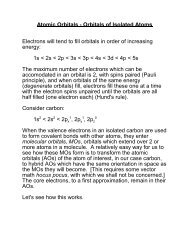Chapter 7 Electron Configurations and the Properties of Atoms 7.1 ...
Chapter 7 Electron Configurations and the Properties of Atoms 7.1 ...
Chapter 7 Electron Configurations and the Properties of Atoms 7.1 ...
Create successful ePaper yourself
Turn your PDF publications into a flip-book with our unique Google optimized e-Paper software.
<strong>Chapter</strong> 7 <strong>Electron</strong>ic <strong>Configurations</strong> <strong>and</strong> <strong>the</strong> <strong>Properties</strong> <strong>of</strong> <strong>Atoms</strong><br />
However, it is common to show all orbitals on a horizontal line when writing orbital box notation<br />
electron configurations in order to make more efficient use <strong>of</strong> space.<br />
Beryllium has two electrons in <strong>the</strong> 1s <strong>and</strong> <strong>the</strong> 2s orbitals.<br />
Boron has five electrons. Four electrons fill <strong>the</strong> 1s <strong>and</strong> 2s orbitals, <strong>and</strong> <strong>the</strong> fifth electron is in a 2p<br />
orbital. Notice that <strong>the</strong> orbital box diagram shows all three 2p orbitals even though only one <strong>of</strong> <strong>the</strong> 2p<br />
orbitals is occupied.<br />
Carbon has six electrons, four in <strong>the</strong> 1s <strong>and</strong> 2s orbitals <strong>and</strong> two in <strong>the</strong> 2p orbitals. When electrons<br />
occupy a subshell with multiple orbitals such as 2p, Hund’s rule <strong>of</strong> maximum multiplicity applies.<br />
This rule states that <strong>the</strong> lowest-energy electron configuration is <strong>the</strong> one where <strong>the</strong> maximum number<br />
<strong>of</strong> electrons is unpaired. In <strong>the</strong> case <strong>of</strong> carbon, this means that <strong>the</strong> two 2p electrons each occupy a<br />
different 2p orbital (Interactive Figure 7.3.2).<br />
Interactive Figure 7.3.2: Apply Hund’s rule <strong>of</strong> maximum multiplicity.<br />
Carbon’s electron configuration has two unpaired electrons in <strong>the</strong> 2p orbitals.<br />
The electron configurations <strong>of</strong> nitrogen, oxygen, fluorine, <strong>and</strong> neon are shown here. Notice that <strong>the</strong><br />
highest-energy orbital for all second-row elements is in <strong>the</strong> second energy level (2s or 2p).<br />
Sodium to Argon The elements in <strong>the</strong> third row <strong>of</strong> <strong>the</strong> periodic table have electrons that occupy<br />
orbitals in <strong>the</strong> third energy level, as shown.<br />
- 8 -
















